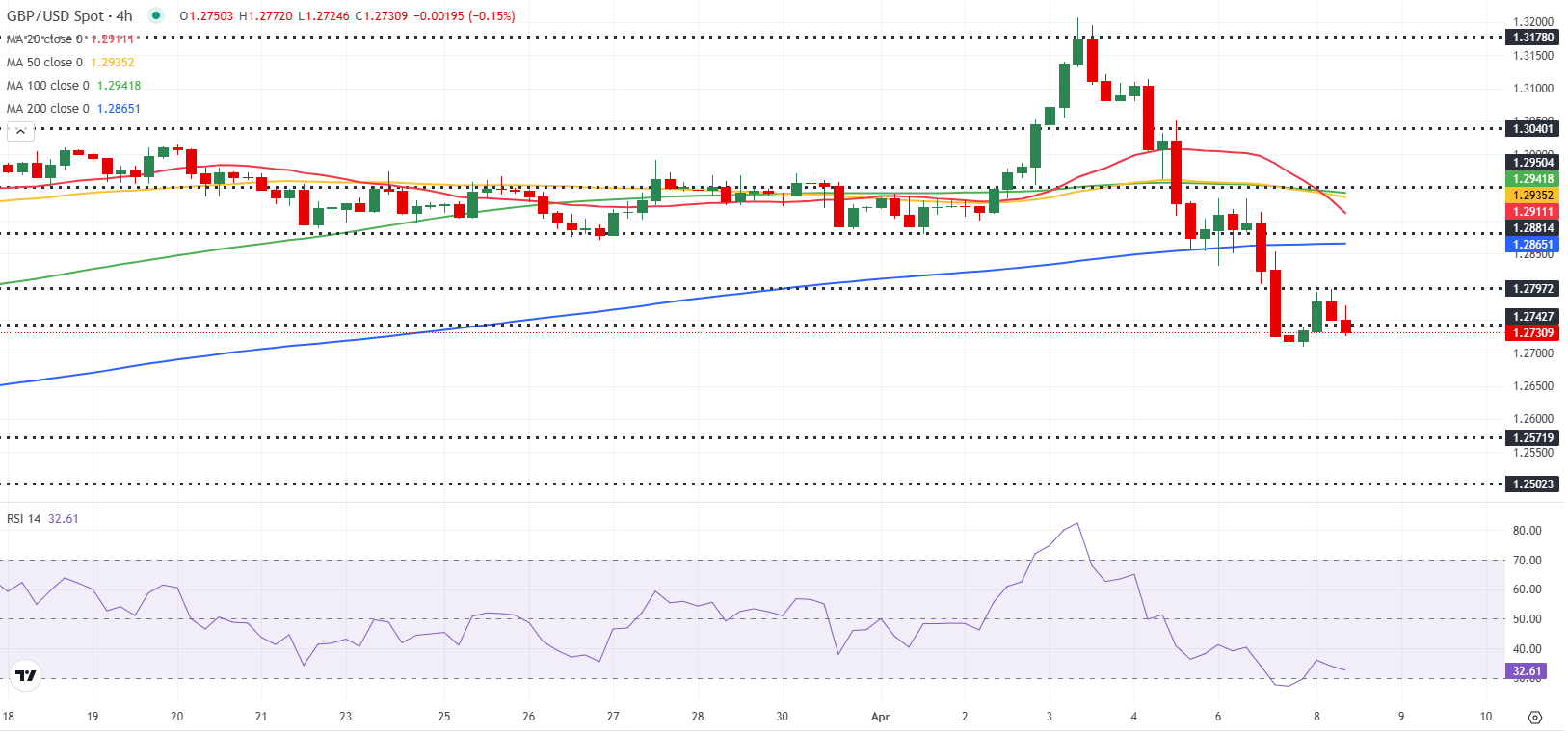- GBP/USD holds steady above 1.2700 in the European session on Tuesday.
- The pair closed below the 200-day SMA for the first time in a month on Monday.
- The positive shift seen in risk mood helps the pair hold its ground.
Following a short-lasting recovery attempt, GBP/USD came under renewed bearish pressure and dropped to its weakest level in a month near 1.2700 on Monday. Although the improving risk mood helps the pair limit its losses on Tuesday, the technical outlook doesn’t hint at an extended recovery.
British Pound PRICE This week
The table below shows the percentage change of British Pound (GBP) against listed major currencies this week. British Pound was the weakest against the Australian Dollar.
| USD | EUR | GBP | JPY | CAD | AUD | NZD | CHF | |
|---|---|---|---|---|---|---|---|---|
| USD | 0.38% | 1.21% | 1.24% | -0.45% | -0.00% | -0.14% | 0.31% | |
| EUR | -0.38% | 1.12% | 1.51% | -0.20% | -0.45% | 0.10% | 0.56% | |
| GBP | -1.21% | -1.12% | -0.90% | -1.31% | -1.55% | -1.01% | -0.55% | |
| JPY | -1.24% | -1.51% | 0.90% | -1.66% | -0.29% | -0.16% | -0.59% | |
| CAD | 0.45% | 0.20% | 1.31% | 1.66% | 0.10% | 0.31% | 0.49% | |
| AUD | 0.00% | 0.45% | 1.55% | 0.29% | -0.10% | 0.55% | 1.00% | |
| NZD | 0.14% | -0.10% | 1.01% | 0.16% | -0.31% | -0.55% | 0.45% | |
| CHF | -0.31% | -0.56% | 0.55% | 0.59% | -0.49% | -1.00% | -0.45% |
The heat map shows percentage changes of major currencies against each other. The base currency is picked from the left column, while the quote currency is picked from the top row. For example, if you pick the British Pound from the left column and move along the horizontal line to the US Dollar, the percentage change displayed in the box will represent GBP (base)/USD (quote).
Safe-haven flows dominated the action at the beginning of the week as US President Donald Trump and White House officials reaffirmed that they will keep tariffs in place. In an interview with Fox News on Monday, Kevin Hassett, Director of the US National Economic Council (NEC), said that Trump is doubling down on something he knows works and added that Trump will listen to trading partners if they offer “really great deals.”
During the American trading hours, Trump took to social media to threaten an additional 50% tariffs on China, after China issued retaliatory tariffs of 34% on US goods on Friday. In response, “if the US insists on a trade war, China will fight until the end,” China’s Foreign Ministry said early Tuesday.
In the European session, US stock index futures rise between 1.5% and 2%, while the UK’s FTSE gains about 2%. In the absence of high-impact data releases, the risk perception could continue to influence GBP/USD’s action.
A bullish action in Wall Street following the opening bell could support the pair. On the flip side, a negative shift in market mood could open the door to another leg lower.
GBP/USD Technical Analysis

GBP/USD closed below the 200-day Simple Moving Average (SMA), currently located at 1.2815, for the first time since early March on Monday. Meanwhile, the Relative Strength Index (RSI) indicator on the 4-hour chart stays below 40, reflecting a bearish bias.
GBP/USD could face the first support level at 1.2700 (static level, round level) before 1.2630 (100-day SMA) and 1.2600 (static level, round level). On the upside, resistances could be seen at 1.2815 (200-day SMA), 1.2880 (static level) and 1.2930 (20-day SMA).
Risk sentiment FAQs
In the world of financial jargon the two widely used terms “risk-on” and “risk off” refer to the level of risk that investors are willing to stomach during the period referenced. In a “risk-on” market, investors are optimistic about the future and more willing to buy risky assets. In a “risk-off” market investors start to ‘play it safe’ because they are worried about the future, and therefore buy less risky assets that are more certain of bringing a return, even if it is relatively modest.
Typically, during periods of “risk-on”, stock markets will rise, most commodities – except Gold – will also gain in value, since they benefit from a positive growth outlook. The currencies of nations that are heavy commodity exporters strengthen because of increased demand, and Cryptocurrencies rise. In a “risk-off” market, Bonds go up – especially major government Bonds – Gold shines, and safe-haven currencies such as the Japanese Yen, Swiss Franc and US Dollar all benefit.
The Australian Dollar (AUD), the Canadian Dollar (CAD), the New Zealand Dollar (NZD) and minor FX like the Ruble (RUB) and the South African Rand (ZAR), all tend to rise in markets that are “risk-on”. This is because the economies of these currencies are heavily reliant on commodity exports for growth, and commodities tend to rise in price during risk-on periods. This is because investors foresee greater demand for raw materials in the future due to heightened economic activity.
The major currencies that tend to rise during periods of “risk-off” are the US Dollar (USD), the Japanese Yen (JPY) and the Swiss Franc (CHF). The US Dollar, because it is the world’s reserve currency, and because in times of crisis investors buy US government debt, which is seen as safe because the largest economy in the world is unlikely to default. The Yen, from increased demand for Japanese government bonds, because a high proportion are held by domestic investors who are unlikely to dump them – even in a crisis. The Swiss Franc, because strict Swiss banking laws offer investors enhanced capital protection.

